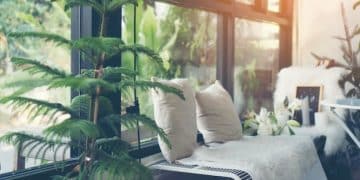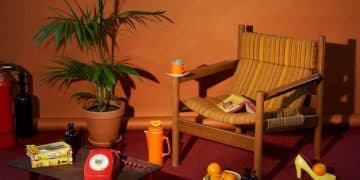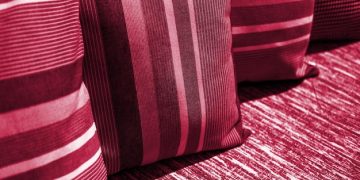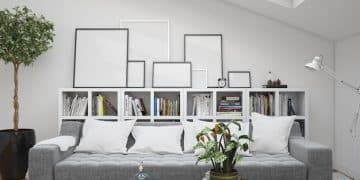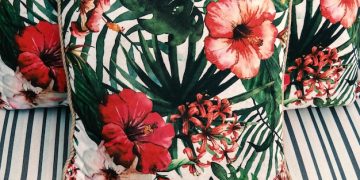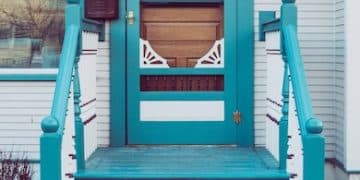The Hottest Home Decor Styles of 2025: Minimalist to Maximalist
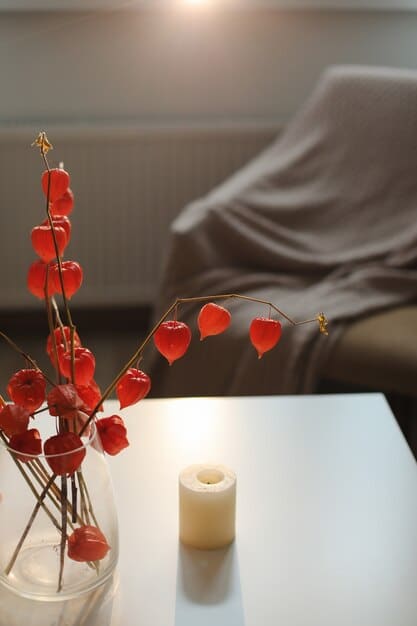
The Hottest Home Decor Styles of 2025 range from the calming simplicity of minimalism, emphasizing clean lines and clutter-free spaces, to the bold self-expression of maximalism, celebrating vibrant colors, patterns, and curated collections.
Get ready to revamp your living spaces with the trends that will define home decor in 2025. From subtle shifts to bold statements, understanding **the hottest home decor styles of 2025: From Minimalist to Maximalist** will help you create a home that’s both stylish and uniquely yours.
Exploring the Enduring Appeal of Minimalism
Minimalism continues to be a dominant force in interior design, offering a serene and uncluttered approach to modern living. Its core principles focus on simplicity, functionality, and intentionality, making it a timeless choice for those seeking a peaceful and organized home environment.
Key Elements of Minimalist Design
Minimalism isn’t just about having less; it’s about making conscious choices about what you bring into your space.
Impact of Color Palettes in Minimalism
The choice of colors in minimalist design plays a crucial role in creating the desired atmosphere of calm and focus.
- Neutral Tones: Whites, grays, and beiges form the foundation, providing a clean and versatile backdrop.
- Monochromatic Schemes: Using variations of a single color adds depth and interest while maintaining simplicity.
- Accent Colors: Soft pastels or muted earth tones can be introduced sparingly to add warmth and visual appeal without overwhelming the space.
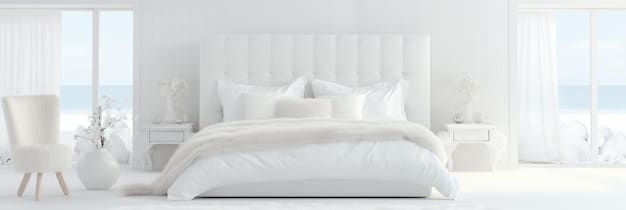
Achieving Functional Simplicity
One of the hallmarks of minimalism is its emphasis on functionality. This means choosing furniture and decor items that serve a purpose and contribute to the overall efficiency of the space.
- Multi-functional Furniture: Opt for pieces like storage ottomans, convertible sofas, and wall-mounted desks that maximize space and minimize clutter.
- Hidden Storage Solutions: Incorporate built-in shelving, under-bed storage, and concealed compartments to keep belongings organized and out of sight.
- Decluttering Regularly: Make it a habit to periodically assess your belongings and remove anything that no longer serves a purpose or brings joy to your life.
Minimalism offers a pathway to a more intentional and serene living environment, fostering a sense of calm and focus in today’s fast-paced world. By embracing clean lines, neutral color palettes, and functional simplicity, you can create a home that promotes well-being and reflects your personal values.
Embracing the Boldness of Maximalism
In stark contrast to minimalism, maximalism celebrates abundance, self-expression, and curated collections. This bold and vibrant style encourages you to embrace patterns, colors, and textures, creating a space that tells a story and reflects your unique personality.
The Heart of Maximalist Design
While it might seem chaotic at first glance, maximalism is about carefully curating a collection of items that resonate with you and arranging them in a way that feels harmonious and visually stimulating.
Layering Patterns and Textures
Pattern mixing is a cornerstone of maximalist design, allowing you to create a dynamic and visually rich environment.
- Mixing Scales: Combine large-scale patterns with smaller, more intricate designs to create visual interest.
- Contrasting Styles: Don’t be afraid to pair geometric patterns with floral prints or animal motifs.
- Incorporating Texture: Add tactile elements like velvet, silk, and woven fabrics to enhance the sensory experience.
The Power of Bold Colors
Color plays a central role in maximalist design, providing an opportunity to express your personality and create a space that feels vibrant and energetic.
- Jewel Tones: Deep blues, emerald greens, and ruby reds add a touch of luxury and drama.
- Unexpected Combinations: Don’t shy away from pairing colors that might seem unconventional, such as orange and purple or pink and green.
- Using Color as a Unifying Element: Choose a few key colors to repeat throughout the space to create a sense of cohesion.
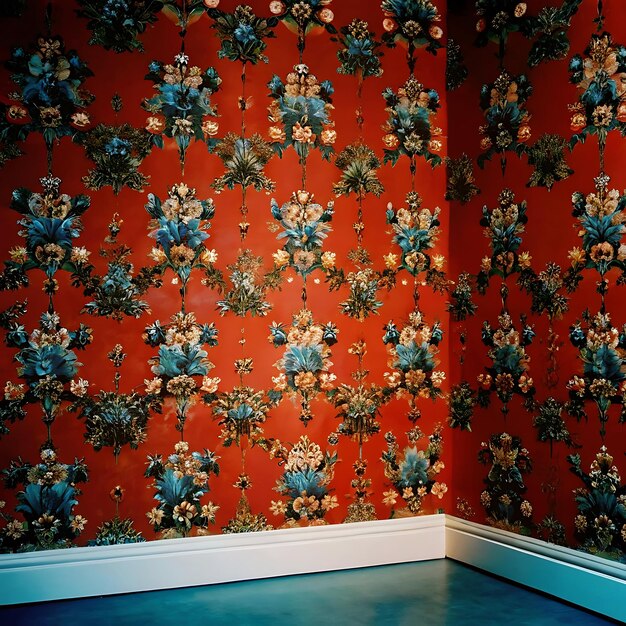
Curating Your Collection with Intention
Maximalism isn’t just about accumulating stuff; it’s about carefully selecting items that hold meaning and contribute to the overall aesthetic of the space.
- Displaying Personal Treasures: Showcase your favorite art pieces, family heirlooms, and travel souvenirs to create a space that tells your story.
- Creating Vignettes: Arrange groups of objects on shelves, tables, and mantels to create visually appealing compositions.
- Embracing Imperfection: Don’t strive for perfection; allow your personality to shine through and embrace the quirks and imperfections that make your space unique.
Maximalism is an invitation to embrace your individuality, surround yourself with things you love, and create a home that is a true reflection of who you are. By layering patterns, mixing colors, and curating your collection with intention, you can transform your living space into a vibrant and inspiring sanctuary.
The Rise of Sustainable and Eco-Friendly Decor
As environmental awareness grows, so does the demand for sustainable and eco-friendly home decor options. The trends in 2025 reflect a conscious effort to reduce our ecological footprint and create homes that are both beautiful and environmentally responsible.
Prioritizing Recycled and Upcycled Materials
Using recycled and upcycled materials is a powerful way to reduce waste and give new life to discarded items.
Embracing Natural and Organic Materials
Choosing natural and organic materials not only reduces your environmental impact but also creates a healthier and more comfortable living environment.
- Organic Cotton and Linen: These materials are grown without the use of harmful pesticides and chemicals, making them a sustainable and skin-friendly choice for bedding, curtains, and upholstery.
- Bamboo and Cork: These fast-growing and renewable resources are excellent alternatives to traditional hardwoods for flooring, furniture, and accessories.
- Wool and Jute: These natural fibers are durable, biodegradable, and add warmth and texture to any space.
Reducing Waste Through Conscious Consumption
Adopting a mindful approach to consumption is key to creating a more sustainable home. Before making a purchase, consider the environmental impact of the product and whether you truly need it.
Sustainable and eco-friendly decor is about making conscious choices that benefit both our homes and the planet. By prioritizing recycled materials, embracing natural resources, and reducing waste, you can create a living space that is beautiful, healthy, and environmentally responsible.
The Influence of Technology in Home Decor
Technology continues to reshape the way we interact with our homes, offering innovative solutions for lighting, climate control, entertainment, and security. In 2025, expect to see even more integration of smart home technology into interior design, creating spaces that are both functional and seamlessly connected.
Smart Lighting Systems
Smart lighting systems allow you to control the brightness, color, and timing of your lights using your smartphone or voice commands.
Smart Climate Control
Smart thermostats learn your preferences and automatically adjust the temperature to optimize comfort and energy savings. These systems can be controlled remotely, allowing you to pre-heat or cool your home before you arrive.
Seamless Integration of Entertainment Systems
Technology enables the seamless integration of entertainment systems into your home decor. Hidden speakers, recessed screens, and wireless connectivity allow you to enjoy your favorite music and movies without sacrificing aesthetics.
Technology is transforming the way we experience our homes, offering unprecedented levels of convenience, comfort, and control. By embracing smart lighting, climate control, and integrated entertainment systems, you can create a living space that is both functional and seamlessly connected.
Biophilic Design: Bringing the Outdoors In
Biophilic design emphasizes the connection between humans and nature, incorporating natural elements and patterns into the built environment. This approach aims to enhance well-being, reduce stress, and create spaces that feel calming and restorative.
Incorporating Natural Light and Ventilation
Maximize natural light by using sheer curtains, light-colored walls, and strategically placed mirrors. Natural ventilation is best achieved with strategically placed windows and doors.
Adding Plants and Greenery
Plants are a cornerstone of biophilic design. They purify the air, add visual interest, and create a sense of tranquility. Choose a variety of plants with different textures, colors, and sizes to create a dynamic and visually stimulating environment.
Using Natural Materials and Textures
Incorporate natural materials like wood, stone, and bamboo into your decor to create a tactile and visually appealing space. These materials evoke a sense of warmth, grounding, and connection to the natural world.
- Wood: Use wood for flooring, furniture, and wall paneling to add warmth and texture.
- Stone: Incorporate stone elements like countertops, fireplaces, and accent walls to create a sense of solidity and connection to the earth.
- Bamboo: Use bamboo for flooring, window treatments, and decorative accessories to add a sustainable and eco-friendly touch.
Biophilic design is a powerful approach to creating homes that are not only beautiful but also promote well-being and connection to nature. By incorporating natural light, plants, and natural materials, you can transform your living space into a calming and restorative sanctuary.
The Resurgence of Art Deco Influence
The elegance and glamour of Art Deco are making a comeback in home decor. This timeless style, characterized by geometric patterns, luxurious materials, and bold colors, adds a touch of sophistication and opulence to any space.
Geometric Patterns and Shapes
Geometric patterns are a defining feature of Art Deco design. Look for repeating motifs, zigzags, chevrons, and sunbursts in textiles, wall coverings, and decorative accessories.
Luxurious Materials and Finishes
Art Deco celebrates luxury and craftsmanship, incorporating high-quality materials like velvet, silk, leather, and exotic woods.
Bold Colors and Metallics
Art Deco color palettes typically feature bold and contrasting hues, such as black and gold, navy and silver, and emerald green and rose gold.
- Black and Gold: This classic combination exudes sophistication and glamour.
- Navy and Silver: These colors create a sense of elegance and refinement.
- Emerald Green and Rose Gold: This pairing adds a touch of vibrancy and modernity.
The resurgence of Art Deco influence offers an opportunity to infuse your home with timeless elegance and sophistication. By embracing geometric patterns, luxurious materials, and bold colors, you can create a space that is both glamorous and inviting.
| Key Trend | Brief Description |
|---|---|
| ✨ Minimalism | Focuses on simplicity, functionality, and neutral color palettes. |
| 🎨 Maximalism | Celebrates abundance, bold colors, and curated collections. |
| 🌱 Eco-Friendly Decor | Emphasizes sustainable materials and conscious consumption. |
| 💡 Smart Home Tech | Integrates technology for lighting, climate control, and entertainment. |
Frequently Asked Questions
▼
Minimalism focuses on simplicity and functionality with neutral colors and uncluttered spaces. Maximalism embraces abundance, bold colors, patterns, and curated collections of personal items.
▼
Prioritize recycled and upcycled materials, embrace natural and organic options like bamboo and organic cotton, and practice conscious consumption by buying less and choosing durable, long-lasting products.
▼
Smart home technology offers convenience, energy savings, and enhanced security. Smart lighting, thermostats, and entertainment systems can be controlled remotely, improving comfort and efficiency.
▼
Incorporate natural light and ventilation, add plants and greenery, and use natural materials like wood and stone. Aim to create a space that feels connected to nature for better well-being.
▼
Art Deco is characterized by bold geometric patterns, luxurious materials such as velvet and silk, and striking color palettes like black and gold or emerald green and rose gold.
Conclusion
As we look ahead to 2025, the world of home decor promises an exciting blend of styles, from the serene simplicity of minimalism to the vibrant self-expression of maximalism. By understanding these trends and incorporating them into your own living spaces, you can create a home that’s both stylish and uniquely yours, reflecting your personality and values.
